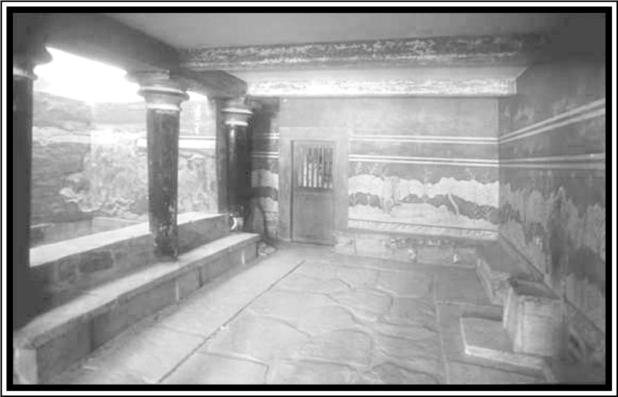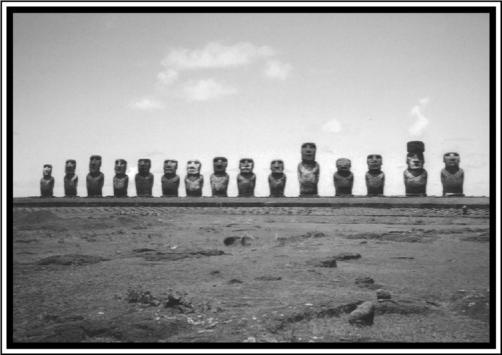Hidden History: Lost Civilizations, Secret Knowledge, and Ancient Mysteries (11 page)
Read Hidden History: Lost Civilizations, Secret Knowledge, and Ancient Mysteries Online
Authors: Brian Haughton
Tags: #Fringe Science, #Gnostic Dementia, #U.S.A., #Alternative History, #Amazon.com, #Retail, #Archaeology, #History


The throne room in the palace of Knossos.
Some of the most extraordinary
discoveries at Knossos have been the
richly colored frescoes that adorned
the plastered walls, and sometimes
even the floors and ceilings. These
murals show princes, courtly ladies,
fish, flowers, and strange games involving young people leaping over charging bulls. When originally found, these
wall paintings were fragmentary, often
with significant parts missing, and
were subsequently reconstructed and
replaced by Evans and artist Piet de
Jong. Consequently, there has been
much controversy over the accuracy of
the reconstructions, though there
seems to be no doubt that many of the
frescoes are of a religious or ritual
nature.
Between 1700 B.C. and 1450 B.C.,
Minoan civilization was at its peak,
with the city of Knossos and the surrounding settlement having a population of perhaps as many as 100,000.
During this period the Minoan centers
survived two major earthquakes, the
most serious of which probably occurred in the mid-17th century B.C.
(though some researchers date it to as
late as 1450 B.C.), and was caused by a
massive volcanic eruption on the
Cycladic island of Thera (modern
Santorini) 62 miles away from Crete.
The explosion from this eruption was
even greater than the atomic blast at
Hiroshima, and blasted the island of
Thera into three separate parts. Finally, in the mid-15th century B.C., due
to a combination of the accumulative
effects of earthquake damage, periodic invasions from the Greek mainland,
and the collapse of their trade networks, the Minoan civilization began
to decline.
Perhaps its layout is quite complex
-resembling a labyrinth-the Palace
of Minos is thought by some to be the
source of the Theseus and the
Minotaur myth. The main part of the
myth begins when Theseus is in Athens and hears about a blood payment
demanded by King Minos of Crete, for
the murder of his son by the Athenians.
This payment involves sending seven
young Athenian men and seven young
virgin girls to Crete every year, where
they are given to the terrible half-bull,
half-man Minotaur. This beast is kept
shut up in a labyrinth designed by the
famous architect Daedalus. Appalled
at this situation, Theseus volunteers
to be part of the yearly sacrifice and
kill the Minotaur. As he is about to set
off for Crete with the intended victims
on a black-sailed ship, his father King
Aegeus makes Theseus promise that
if he is successful in slaying the
Minotaur, he will, on his return,
change the ship's black sail to white,
as an indication that he is alive and
well. When the group arrives at
Knossos, King Minos' daughter
Ariadne immediately falls in love with
Theseus and agrees to help him kill
the Minotaur. Ariadne gives Theseus
a silk thread, which the hero uses to
help him find his way out of the labyrinth after he has killed the monster.
The couple subsequently set sail for
Athens, but on the way Theseus
deserts Ariadne on the island of
Naxos, where she is rescued by the god
Dionysus. Unfortunately, on his approach to Athens, Theseus forgets his
promise to his father and leaves the
black sail on the ship. King Aegeus,
thinking his son has been killed, leaps
to his death from a cliff.
There is evidence that Knossos's
link with Theseus and the Minotaur
was kept alive long after the Minoans
ceased to exist. This comes mainly in
the form of coinage, and examples include a silver coin from Knossos dated
c. 500 to 413 B.C., which depicts a running Minotaur on one side and a maze
or labyrinth on the reverse. Another
coin shows the head of Ariadne surrounded by a labyrinth. The Minotaur
and labyrinth were also extremely
popular in the Roman period, and numerous mosaics illustrate the Knossos
labyrinth. The most spectacular of
these is probably that from a Roman
villa near Salzburg, in western Austria,
dating to the fifth century A.D. However, some researchers do not believe
the Minotaur originates with the architecture of the Palace at Knossos.
They point out the difference between
a labyrinth, which has only one path
to the center, and a maze, which can
have many. Indeed it is tempting to see
the labyrinth as relating to the maze
as a symbol of the mysteries of life and
death: An abstract concept connected
with religious ritual, where the
Minotaur waiting at the center of the
labyrinth represents something concealed in the heart of all of us.
The story of the 14 youths brought
from Athens to Knossos as a sacrifice
to the Minotaur has always been
thought of as simple myth. But there
is archaeological evidence that perhaps gives some support to this horrific tale. In 1979, in the basement of
the North House within the Knossos
complex, excavators discovered 337
human bones. Analysis of these bones showed that they represented at least
four individuals, all children. Further
examination of the bones revealed the
grisly detail that 79 of them showed
traces of cut marks made by a fine
blade, which bone specialist Loius
Binford interpreted as being made to
remove the flesh. Ruling out the
possibilty that the defleshing of the
bones was part of a burial rite (only
lumps of flesh had been removed, not
every piece), excavator of the site
Peter Warren, Professor of Classical
Archaeology at the University of
Bristol, concluded that the children
were probably ritually sacrificed and
then eaten.
At the four-room sanctuary at
Anemospilia, only 4.3 miles south of
Knossos (first excavated in 1979 by
J. Sakellarikas) another find suggestive of human sacrifice was made.
When investigating the temple's western room, archaeologists found three
skeletons. The first was an 18-year-old
male lying on his right side on an altar in the center of the room, a bronze
dagger at his chest, and his feet tied.
Near to the altar there had once been
a pillar with a channel running around
its base, seemingly intended to catch
blood dripping from a sacrifice. Examination of the dead youth's bones
revealed that he had probably died
from loss of blood. In the southwest
corner of the room, the remains of a
28-year-old female were found
sprawled across the floor, and near the
altar the skeleton of a 5-foot 9-inch tall
male in his late thirties was discovered. This man's hands were raised,
as if trying to protect himself, and his
legs had been broken by falling masonry. A further skeleton, too damaged
to identify, was also found in the building. The temple was destroyed in a fire
around 1600 B.C., which probably resulted from an earthquake. Three of
these individuals had been killed by
the collapsing roof and masonry of the
upper walls, but it seems that the teenager was already dead by this time.
According to the archaeological
evidence, human sacrifice does not
seem to have been widespread on
Minoan Crete. The examples cited
may have been exceptions brought on
by a desperate attempt to appease the
gods in troubled times, probably during violent earthquake activity. A
point worthy of note is that at both the
North House at Knossos and at at the
Anemospilia temple, the sacrifices
were of young adults or children, bringing to mind the seven young men and
seven young women sent by Athens to
satisfy the Minotaur. Perhaps the origins of the Knossos labyrinth legend
were partly in these horrific practices
of human sacrifice, made in unstable
times, when the safety of the entire
community was thought to be at risk.


© Thanassis Vembos.
Agroup of moai on their ceremonial platforms.
The most isolated inhabited island
in the world, Easter Island (nowadays
called Rapa Nui, which means Great
Island) is located in the southeast Pacific Ocean, 2,000 miles from the nearest population center. The island is
roughly triangular in shape and composed of volcanic rock. It is most famous for its large number of enigmatic
giant stone statues scattered along the
coast, and perhaps less so for its
undeciphered and mysterious script
known as Rongorongo.
The original inhabitants of Easter
Island called it Te Pito 0 Te Henua
(Navel of the Earth), but who these first
settlers were or where they came from
are much debated subjects. Probably the
most controversial theory about the
peopling of the island was originated
by the Norwegian explorer and archaeologist Thor Heyerdahl. According to
Heyerdahl, Easter Island was partly
settled by a pre-Incan society sailing
from Peru in substantial ocean-going
rafts, with the help of the prevailing
westerly trade winds. In 1947, to prove
it was theoretically possible to make
it across the Pacific in such a vessel,
Heyerdahl built a replica of one of
these balsa wood crafts and named it
the Kon-Tiki, after an Incan Sun God.
Once out in the Pacific, Heyerdahl and
his team sailed for 101 days across
4,349 miles of open sea before crashing into the reef at Raroia atoll, in the Tuamotu Archipelago, east of Tahiti.
In 1951, the documentary Kon-Tiki,
relating the expedition, won an Academy Award. The Kon-Tiki expedition
proved that it was technically possible
for South American peoples to have
crossed the Pacific in a raft and settled
the Polynesian Islands. But there are
one or two problems with Heyerdahl's
experiment. The Kon-Tiki was a type
of vessel copied from rafts in the 16th
century A.D., after the sail had been introduced by the Spanish. So it is not
certain how close his raft was in design
to those in use 800 years before the appearance of the Spanish, when the supposed colonizing expeditions to the
Pacific took place. Furthermore, when
Heyerdahl first attempted to set out on
his journey, the offshore currents were
so strong that the Kon-Tiki needed to
be towed out to sea a distance of 50
miles before it could be sailed.
Heyerdahl also included botanical,
linguistic, and architectural evidence
in his theory of a South American origin for the Easter Islanders, around
A.D. 800. However, archaeological evidence gathered in the years since
Heyerdahl made his daring voyage has
all but disproved his hypothesis, especially as the settlement of the island was already complete by the time
of the proposed trans-Pacific journey.
So where did the first inhabitants of
Easter Island come from? Due to its
extremely isolated position, a voyage
to Easter Island from anywhere would
have taken at least two weeks, over
thousands of miles of open sea. Such a
journey clearly indicates a maritime
people. Polynesian cultures were expert sailors and constructed huge
ocean-going canoes and rafts, navigating by using the position of the stars,
wind direction, and the natural movements of birds and fish. Linguistic evidence points to the settlement of Rapa
Nui by peoples from East Polynesia
between A.D. 300 and A.D. 700, possibly
from the Marquesas Islands or Pitcairn
Island. The latter is the nearest inhabited land, lying 1,199 miles to the west.
This colonization was probably part of
a gradual eastward migration, originating in southeast Asia around 2000 B.C.
A western origin is also indicated by
an Easter Island myth. This myth describes how, around 1,500 years ago, a
Polynesian king named Hotu Matua
(the Great Parent) came to the island
with his wife and family in a double
canoe, by sailing in the direction of the
sunrise from an unspecified Polynesian
island. Just before he died, Hotu Matua
traveled to the western extreme of Easter Island to look for the last time towards his homeland. Recent evidence
from DNA studies has practically ruled
out colonization by South Americans.
Skeletons from burial sites on Easter
Island have been found to contain a genetic marker, called the Polynesian
Motif, proving that the Easter Islanders are descendents of settlers from
eastern Polynesia, not South America.
